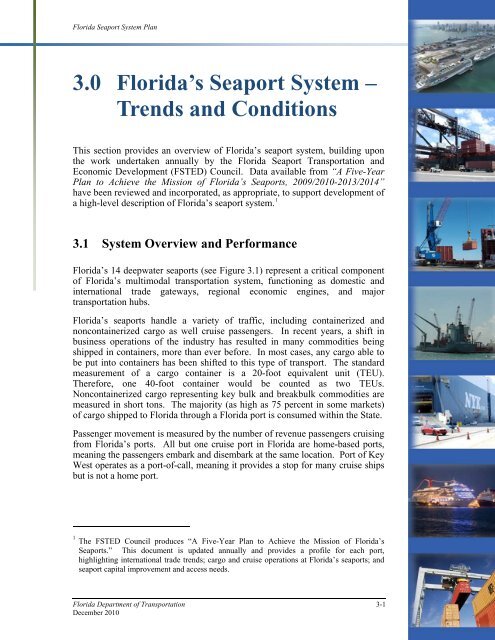Florida Seaport System Plan - SeaCIP
Florida Seaport System Plan - SeaCIP
Florida Seaport System Plan - SeaCIP
You also want an ePaper? Increase the reach of your titles
YUMPU automatically turns print PDFs into web optimized ePapers that Google loves.
<strong>Florida</strong> <strong>Seaport</strong> <strong>System</strong> <strong>Plan</strong><br />
3.0 <strong>Florida</strong>’s <strong>Seaport</strong> <strong>System</strong> –<br />
Trends and Conditions<br />
This section provides an overview of <strong>Florida</strong>’s seaport system, building upon<br />
the work undertaken annually by the <strong>Florida</strong> <strong>Seaport</strong> Transportation and<br />
Economic Development (FSTED) Council. Data available from “A Five-Year<br />
<strong>Plan</strong> to Achieve the Mission of <strong>Florida</strong>’s <strong>Seaport</strong>s, 2009/2010-2013/2014”<br />
have been reviewed and incorporated, as appropriate, to support development of<br />
a high-level description of <strong>Florida</strong>’s seaport system. 1<br />
3.1 <strong>System</strong> Overview and Performance<br />
<strong>Florida</strong>’s 14 deepwater seaports (see Figure 3.1) represent a critical component<br />
of <strong>Florida</strong>’s multimodal transportation system, functioning as domestic and<br />
international trade gateways, regional economic engines, and major<br />
transportation hubs.<br />
<strong>Florida</strong>’s seaports handle a variety of traffic, including containerized and<br />
noncontainerized cargo as well cruise passengers. In recent years, a shift in<br />
business operations of the industry has resulted in many commodities being<br />
shipped in containers, more than ever before. In most cases, any cargo able to<br />
be put into containers has been shifted to this type of transport. The standard<br />
measurement of a cargo container is a 20-foot equivalent unit (TEU).<br />
Therefore, one 40-foot container would be counted as two TEUs.<br />
Noncontainerized cargo representing key bulk and breakbulk commodities are<br />
measured in short tons. The majority (as high as 75 percent in some markets)<br />
of cargo shipped to <strong>Florida</strong> through a <strong>Florida</strong> port is consumed within the State.<br />
Passenger movement is measured by the number of revenue passengers cruising<br />
from <strong>Florida</strong>’s ports. All but one cruise port in <strong>Florida</strong> are home-based ports,<br />
meaning the passengers embark and disembark at the same location. Port of Key<br />
West operates as a port-of-call, meaning it provides a stop for many cruise ships<br />
but is not a home port.<br />
1<br />
The FSTED Council produces “A Five-Year <strong>Plan</strong> to Achieve the Mission of <strong>Florida</strong>’s<br />
<strong>Seaport</strong>s.” This document is updated annually and provides a profile for each port,<br />
highlighting international trade trends; cargo and cruise operations at <strong>Florida</strong>’s seaports; and<br />
seaport capital improvement and access needs.<br />
<strong>Florida</strong> Department of Transportation 3-1<br />
December 2010
















